of wood. For the last ten months I have been picking up sticks and such along the path to use as kindling in our multifuel stove. Why buy it if you can collect it and clean up the paths at the same time is my philosophy.
Mike eventually started picking up the kindling size with me. However, any time I saw something bigger that could be cut into smallish "logs" for our stove, and there were LOTS of them last winter and this spring due to the high winds, Mike was not hot on the idea of taking advantage of them.
But, I kept trying (nagging) and finally he has started to see my logic. :-) The wood is great for those small quick fires you need this time of year to take the chill off or when everything just seem damp.
So, we have been "harvesting" larger branches and Mike has been cutting them up into appropriate sized pieces and making a log pile on the roof. All nice and neat and accessible.
Well, then there was yesterday. One of the boaters told Mike about a limb from an ash tree that was there just waiting to be re-homed. So, with saw in hand off went Mike to see what he could glean. Once he had cut several longer limbs off the bigger section he came back to enlist some help in dragging them home.
I, of course, was drafted. But, he also enlisted the help of two young gentlemen and their dad from the boat parked ahead of us. So back we all went to get our limbs and bring them to the boat.
Dad, using the excuse of working up an appetite, suggested that he and the boys help Mike harvest some more before dark. And, off they went.
The result, a roof full of long limbs waiting to be cut and stacked. I really don't think we could get much more up there right now. Truly.
As a thank you for their help I baked a simple fruit cake for the mom and dad and some extra chocolaty brownies for the boys. Little enough for all they did.
Unfortunately, that wonderful family has left now and are heading home to start the new school year. Hopefully we run across each other again in our travels.
Friday, August 29, 2014
Tale of the Crypt and More
Before leaving Ripon we took a walk through the cathedral there. The oldest part dates from the 7th century and includes a crypt that symbolizes Christ's burial crypt. Once, it contained religious relics and people went there to pray. Today, it is empty signifying Christ's rising from the dead. It is very small and the stairway down is VERY narrow. For a claustrophobic person such as myself it took a lot of mental encouraging of myself to make it down there and back up without creating a scene. (Mike does so hate that. :-) ) But, I am very glad I put on my big girl knickers and did it. Well worth it.
Also in the cathedral, on the end of one of the choir stalls, is a carving of a rabbit being caught and another
rabbit disappearing down the rabbit hole. It is believed this was part of the inspiration for Alice in Wonderland since Lewis Carroll was once part of the choir at the cathedral when his father worked there.
If you sit in the choir stalls and look up to the organ overhead you will see a hand emerging from the wall in front of the organ. This was used to conduct the choir. The hand still works but today they opt for a director that appears in person and not just a hand.
We are now re-tracing our way back to York and then will move on to Selby. Such is the fact of life when a canal dead ends.
We have come across some new ducks we did not see on our way up the canal. They are white and black and I have nicknamed them dalmatian ducks since that is what they remind me of. I have been busy conversing with them while they are busy eating what I throw out for them. Sometimes they even quack back.
Today we are waiting for the diesel to be delivered to the pumps across the canal so that we can top up our tank before leaving the canal for the river. It is always prudent to make sure you do not run out of gas on a river. It may make life less interesting but it does make it safer. Let us hope the diesel arrives before the rain.
You Never Miss Google Until Google is Not There
Yesterday, No Google.
Do you have any idea how many sites use Google or Google apps?
A. LOT.
Even if you use Yahoo to search you still can't get to the links you find because, you guessed it, they use a Google app.
I was pretty bummed yesterday.
I couldn't even click through on an email to read the whole thing because that too required a Google app.
I think Google has a monopoly going here.
Luckily, today Google is back. Yeah!
Do you have any idea how many sites use Google or Google apps?
A. LOT.
Even if you use Yahoo to search you still can't get to the links you find because, you guessed it, they use a Google app.
I was pretty bummed yesterday.
I couldn't even click through on an email to read the whole thing because that too required a Google app.
I think Google has a monopoly going here.
Luckily, today Google is back. Yeah!
Monday, August 25, 2014
Yearly Housecleaning on a Narrowboat
First, my mother and my grandmother would be oh so embarrassed that I said yearly. They did a fall and a spring cleaning and boy did they do a weekly in between! They were definitely made of sterner stuff.
We have been living on the boat for close to a year now. There are some things I purchased thinking they would work well that did 't or that I have rarely, if ever used. Off to the charity shop they go.
I thought I arranged things PERFECTLY to take advantage of space and to be convenient. Not so much. Things are being rethought and rearranged, even in our small space.
I tried to buy everything I thought we would REALLY need. I missed a few, imagine that.
When I chose my wardrobe for over here I took A LOT of time and thought planning and thinking about what it should be. Besides my jeans and a very few other things, I got it all wrong. The wrong things go to a charity shop and some new things come home to the boat. That's life, I guess.
I am still trying to get a handle on how much perishable and non perishable food to buy at one time. But I don't hold out much hope on that one. :-) If you look up "overzealous stockpiler" I am sure you will find my picture there, seriously.
P.S. My goal is to clean every surface VERY THOROUGHLY by Christmas. Wish me luck.
We have been living on the boat for close to a year now. There are some things I purchased thinking they would work well that did 't or that I have rarely, if ever used. Off to the charity shop they go.
I thought I arranged things PERFECTLY to take advantage of space and to be convenient. Not so much. Things are being rethought and rearranged, even in our small space.
I tried to buy everything I thought we would REALLY need. I missed a few, imagine that.
When I chose my wardrobe for over here I took A LOT of time and thought planning and thinking about what it should be. Besides my jeans and a very few other things, I got it all wrong. The wrong things go to a charity shop and some new things come home to the boat. That's life, I guess.
I am still trying to get a handle on how much perishable and non perishable food to buy at one time. But I don't hold out much hope on that one. :-) If you look up "overzealous stockpiler" I am sure you will find my picture there, seriously.
P.S. My goal is to clean every surface VERY THOROUGHLY by Christmas. Wish me luck.
Really? This soon?
I am sitting in the boat.
It looks like fall outside.
It feels like fall outside.
I want a fire to warm things up.
I wore a top and a sweater and still felt cold today.
My knees are telling me the weather is changing.
And, what the hey, it is starting to get dark MUCH earlier.
No, No it can't be!
Is summer really almost (or not almost ) over?
I. AM. NOT. READY>
It looks like fall outside.
It feels like fall outside.
I want a fire to warm things up.
I wore a top and a sweater and still felt cold today.
My knees are telling me the weather is changing.
And, what the hey, it is starting to get dark MUCH earlier.
No, No it can't be!
Is summer really almost (or not almost ) over?
I. AM. NOT. READY>
The Ouse, the Ure, and the Ripon Canal
We left York once we had sent Ellen on her way and continued our travels on the non tidal part of the River Ouse. Then, a funny thing happens.
As you travel north you will go past the Ouse Beck. Just north of the Beck this exact same river, no turns, no nothing, suddenly changes names and becomes the River Ure. We followed the Ure until, because of the need to bypass a weir, we entered the Ripon Canal. Traveling to its end, we are now moored in the town of Ripon, as far north into Yorkshire as the canal now travels.
Ripon is home to a stately, impressive and strangely elegant 7th century cathedral. To think such a building could have been built 14 centuries ago amazes me (even with the changes made over time). A testament to man's spirit,belief in his God, and desire to glorify that God.
In the center of the town market square stands this 300 year old, 90 ft high obelisk, towering over everything around it. Markets have been held in this square for hundreds of years and are still a part of the city's attractions.
Every evening at 9pm the city's official Hornblower sounds the 'Setting of the Watch' to assure everyone that they are in safekeeping for the night - a ritual that has occurred every night for over 1,100 years. Every evening the Hornblower blows his horn at the four corners of the obelisk in Ripon Market. Such a ritual was common across Britain for centuries but now only Ripon continues to do so. It adds to the town's old world charm.
The horn has become the symbol of the city and represents Ripon on the Harrogate borough coat of arms.
Ripon abounds with many quaint medieval streets (filled with fascinating shops and tearooms), and both Georgian and medieval buildings. My "job" tomorrow is to take myself off to visit this charming town and its wonderful buildings. It's a tough life. :-)
Saturday, August 23, 2014
York: So Much to See, So Little Time
Well, the visit with DD1 is over and she is now in France visiting friends and enjoying the wine. While she was here, however, we had a great time exploring the city of York. If you ever get the chance it is definitely a place you should visit.

The city is jammed with history. Archaeology is big here and new digs are always unearthing treasures from one era or another. You are literally walking on history wherever you go in the city.
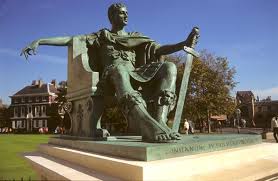
I knew the Romans spent time in England but I did not know that 3 emperors actually ruled the Roman Empire, at least part of the time, from York.

Later, York was known as the capital city of the north. And, when William of Normandy invaded in 1066 he had such trouble with the "locals" he built to castles in York to intimidate and control them. He also burned houses and farms, killed livestock and destroyed the area north of York to such an extent that 100,000 people starved to death as a result. It is commonly acknowledged that Yorkshire has still not fully recovered from this assault on the area. For proof, check the population south of York and north of the city. Big difference.

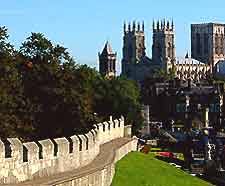

York, as was common in the middle ages, was a walled city. However, unlike most cities, large portions of the city walls still exist and walking along them is a popular tourist and non-tourist activity.

Many of the older streets remain in the city with probably the most famous being the Shambles. The windy street is narrow, the timbered buildings almost meeting in the middle, and the road surface still cobbled.

I discovered that the timber framed houses we Americans call Tudor, a misnomer since they actually started earlier in history, were not designed to have the wooden framing timbers visible. They were to be plastered over to protect them from the elements. It was not until later, I believe the guide said the Victorian Era, were the timbers uncovered because exposing them was deemed more attractive.
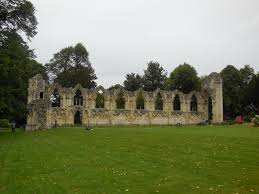
York was once home to one of the largest and wealthiest monasteries in Europe, until Henry VIII closed it and began to dismantle the buildings. What remains now are the beautifully evocative ruins of part of the outside walls of the monastery's church.
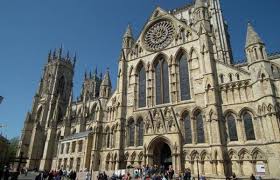
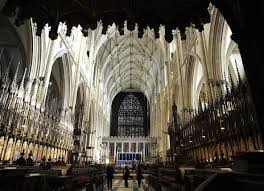

York Minster, an awe inspiring Gothic cathedral that took 250 years to construct, and has a huge stained glass window: The Great East Window (the size of two tennis courts according to the guide), that is now undergoing cleaning and restoration. By law, no building in York is allowed to be higher than the Minster.


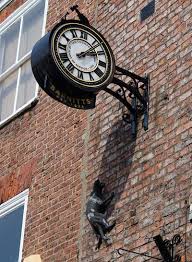
The oak pews in the Minster are adorned with mice (the trademark of the carpenter who made them). It is fitting, then, that throughout the city you will find stone or metal cats perched on window sills, on the brackets for signs, climbing up the walls of buildings and sitting on roofs overlooking the city. Where there are mice there must be cats.

During some previous restoration work to shore up the Minster's foundation it was discovered that the Minster had been constructed upon the ruins of a Roman barracks and basilica. These discoveries are now on display in the Minster's Undercroft.
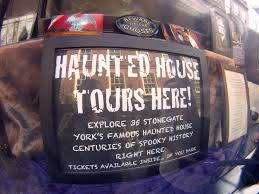
York is also said to be the most haunted city in Europe and evening ghost walking tours abound if you are not faint of heart. Who knows, you might experience and unexplainable icy wind or see a hooded figure of a long dead monk.

York's location on the non-tidal portion of the River Ouse allows for wonderful walks along the river's shoreline.

Part of this stretch is named in honor of Dame Judy Dench, think M in James Bond movies, who grew up and got her start here. Boat sightseeing tours are also available. Seeing the town from the water gives you a completely different perspective.


For children of all ages and chocolate lovers especially, visiting the York Chocolate Museum and discovering the history of British chocolate would be a fun afternoon. You even get to make and then eat your own special chocolate lolly. York, among others, is home to the now world famous KitKat bar.
The city is jammed with history. Archaeology is big here and new digs are always unearthing treasures from one era or another. You are literally walking on history wherever you go in the city.
I knew the Romans spent time in England but I did not know that 3 emperors actually ruled the Roman Empire, at least part of the time, from York.
Later, York was known as the capital city of the north. And, when William of Normandy invaded in 1066 he had such trouble with the "locals" he built to castles in York to intimidate and control them. He also burned houses and farms, killed livestock and destroyed the area north of York to such an extent that 100,000 people starved to death as a result. It is commonly acknowledged that Yorkshire has still not fully recovered from this assault on the area. For proof, check the population south of York and north of the city. Big difference.
York, as was common in the middle ages, was a walled city. However, unlike most cities, large portions of the city walls still exist and walking along them is a popular tourist and non-tourist activity.
Many of the older streets remain in the city with probably the most famous being the Shambles. The windy street is narrow, the timbered buildings almost meeting in the middle, and the road surface still cobbled.
I discovered that the timber framed houses we Americans call Tudor, a misnomer since they actually started earlier in history, were not designed to have the wooden framing timbers visible. They were to be plastered over to protect them from the elements. It was not until later, I believe the guide said the Victorian Era, were the timbers uncovered because exposing them was deemed more attractive.
York was once home to one of the largest and wealthiest monasteries in Europe, until Henry VIII closed it and began to dismantle the buildings. What remains now are the beautifully evocative ruins of part of the outside walls of the monastery's church.
York Minster, an awe inspiring Gothic cathedral that took 250 years to construct, and has a huge stained glass window: The Great East Window (the size of two tennis courts according to the guide), that is now undergoing cleaning and restoration. By law, no building in York is allowed to be higher than the Minster.
The oak pews in the Minster are adorned with mice (the trademark of the carpenter who made them). It is fitting, then, that throughout the city you will find stone or metal cats perched on window sills, on the brackets for signs, climbing up the walls of buildings and sitting on roofs overlooking the city. Where there are mice there must be cats.
During some previous restoration work to shore up the Minster's foundation it was discovered that the Minster had been constructed upon the ruins of a Roman barracks and basilica. These discoveries are now on display in the Minster's Undercroft.
York is also said to be the most haunted city in Europe and evening ghost walking tours abound if you are not faint of heart. Who knows, you might experience and unexplainable icy wind or see a hooded figure of a long dead monk.
York's location on the non-tidal portion of the River Ouse allows for wonderful walks along the river's shoreline.
Part of this stretch is named in honor of Dame Judy Dench, think M in James Bond movies, who grew up and got her start here. Boat sightseeing tours are also available. Seeing the town from the water gives you a completely different perspective.
For children of all ages and chocolate lovers especially, visiting the York Chocolate Museum and discovering the history of British chocolate would be a fun afternoon. You even get to make and then eat your own special chocolate lolly. York, among others, is home to the now world famous KitKat bar.
Sunday, August 17, 2014
We Interrupt this Blog....
for a visit from DD1 who has landed, is through customs, and on a train heading our way even as I type.
We will be exploring York, enjoying each others' company and sampling good food and drink for the next few days.
This blog will resume once she is on her way to visit friends in Paris. See you then.
We will be exploring York, enjoying each others' company and sampling good food and drink for the next few days.
This blog will resume once she is on her way to visit friends in Paris. See you then.
Ghost: the Musical
Yesterday afternoon Mike and I took in a community theater production of the above here in York.
It. Was. Wonderful!
The theater was intimate so that you could really see the emotion on the actor's faces.
The sets were minimalist but effective and evocative.
The lighting was superb.
The actors were very talented both in their craft of acting and in singing what, to me, appeared to be a challenging score.
The result: a fantastic experience that I would have gladly spent much more for than our OAP rate of about £11 each.
Most of the cast and volunteer crew appeared to be students from the local schools and universities. I bet some will be well known professionals some day, if I could only remember their names so that I could recognize them. :-)
The male lead, played by Patrick Swaytzee in the movie (be still my heart), was the only actor without professional training but you would NEVER have known it. His acting, timing, facial expressions, voice, etc. was right up to standard and then some. The last time he sings Unchained Meldody he sounds as if he is barely holding back tears. Very moving.
The audience had a lot of teens and tweens but they were not at all disruptive. Mike and I were quite impressed. Having gone to community theater in college towns in the US, we have seen college age audience members behave much worse on a very regular basis. Cudos to their parents for raising polite children.
It. Was. Wonderful!
The theater was intimate so that you could really see the emotion on the actor's faces.
The sets were minimalist but effective and evocative.
The lighting was superb.
The actors were very talented both in their craft of acting and in singing what, to me, appeared to be a challenging score.
The result: a fantastic experience that I would have gladly spent much more for than our OAP rate of about £11 each.
Most of the cast and volunteer crew appeared to be students from the local schools and universities. I bet some will be well known professionals some day, if I could only remember their names so that I could recognize them. :-)
The male lead, played by Patrick Swaytzee in the movie (be still my heart), was the only actor without professional training but you would NEVER have known it. His acting, timing, facial expressions, voice, etc. was right up to standard and then some. The last time he sings Unchained Meldody he sounds as if he is barely holding back tears. Very moving.
The audience had a lot of teens and tweens but they were not at all disruptive. Mike and I were quite impressed. Having gone to community theater in college towns in the US, we have seen college age audience members behave much worse on a very regular basis. Cudos to their parents for raising polite children.
Friday, August 15, 2014
Stolkholm, Sweden, Worth A Return Someday
Stockholm: Beauty on Water
Their city slogan says it all.
Stolkholm is built on fourteen islands that are connected by over fifty bridges. The city is surrounded by 24,000 other islands that are full of summer homes for Stolkholm and other Swedish residents. For example, the members of ABBA have homes there.
Above is the Royal Palace, the King's official residence and where some offices of his government are housed, is located in the center of Stolkholm. The palace is also home to five museums. It is, however, no longer the actual residence of the royal family.
The king and his family moved out of Stockholm's city center when their three children were small and onto an island, just outside the city, in Lake Malaren. They now reside in the 17th century Drottningholm Palace. Built in the17th century, this palace has been designated a UNESCO World Heritage site and is the best preserved palace in Sweden.
Prince Carl Philip, the middle child and only son, was born the heir apparent. However, a constitutional reform, which was already under way at the time of his birth, later made his older sister, Victoria, the heir apparent and Crown Princess of Sweden on 1 January 1980. This came about due to Sweden's adoption of the principles of absolute primogeniture, which hold that the oldest child of whatever sex is the heir apparent. Previously, the oldest male child was the heir, taking precedence over any older females. Sweden was the first monarchy to adopt absolute primogeniture.
TheVasa Museum is home to a restored warship, the Vasa, which sank on August 10,1628 in sight of the harbor on its maiden voyage. Although the cannons were salvaged in 1661, the wreck itself was not salvaged until 1961 after 333 years at the bottom of the sea. Beacause the ship sunk in brakish water many of the creatures that would have destroyed the wooden vessel were not present. Therefore, the reconstructed vessel is 98% original. The Vasa was constructed from 1626-1628's using a design mandated by the king for two tiers of cannon. The weight of these extra cannon made the Vasa top heavy and unseaworthy. But, everyone was reluctant to tell the king. Therefore, she sank.
Stadshuset: Stockholm's City Hall and the site of the Nobel Prize presentations and banquet each year.
The Stockholm Music Museum was founded 1899 and pays tribute to Sweden's folk dance music, waltz, polka, schottische, mazurka plus the more modern music of ABBA and Roxette. Above is the wing of the museum that houses the permanent ABBA exhibition. In the exhibit you will see example of the group's stage clothes, artifacts, concert footage, interviews etc. The commentary on the tape that guides you through the museum is done by the members of ABBA. Am I the only one who did not know that ABBA is an acronym of the first letters of the band members' first names (Agnetha, Benny, Björn and Anni-Frid).
SOFO is the trendy section of Stockholm and stands for "South of Folkungagatan". It is bounded by Folkungagatan street to the north, Ringvägen to the south and in the east and west by Erstagatan and Götgatan, respectively.
The name SoFo is a pun on the Soho districts in London and Manhattan, and is an area of creative and innovative fashion and retailing. In particular, many Swedish fashion designers are located in SoFo.
Although compact, SoFo also offers a wide selection of restaurants, bars, coffee shops, and art galleries.
The character Pippi Longstocking was invented by writer Astrid Lindgren for her daughter to amuse her while she was ill and bed-ridden. The book has become one of the most beloved children's books in the world and has been translated into 60 languages.
I remember a Halloween years ago when my niece dressed up and went trick or treating as Pippi Longstocking. And a very cute one she was, too.
For a reason I can not yet understand, Pippi Longstocking is featured in the Vasa Museum as part of their children's museum. Again, WHY?
Tuesday, August 12, 2014
Duck Weed Blankets Abound
See that thick carpet of green. It is about four to five inches thick!
It can fool dogs into thinking it is grass and they try to walk on it, without success.
Small song birds can land on it and sit there just fine.
Small sticks can rest on it with out a problem.
It really does look like sculpted carpet. In fact, my folks had some like this in our house in the 1960's.
This a living and growing carpet made up of millions or billions of little plants called duck weed.
This tiny, rounded leaf plant floats on the water surface and resembles a mass of young cress plants.
They multiply rapidly and quickly fill any open surface of slower moving water like ponds and canals.
Weed-eating water birds, such as ducks, moorhens and coots will feast on it. Chickens also enjoy it if harvested and given to them.
Duckweed is an important high-protein food source for waterfowl and also is eaten by humans in some parts of Southeast Asia.
It contains more protein than soybeans and is thought to be a significant potential food source to help feed the world's hungry.
.
Duckweed is also being studied by researchers around the world as a possible source of clean, cost-effective and renewable energy.
Duckweed is a good candidate as a biofuel because as a biomass it grows rapidly, has 5 to 6 times as much starch as corn, and does not contribute to global warming.
Duckweed is considered a carbon neutral energy source, because unlike most fuels, as it grows it removes carbon dioxide from the atmosphere.
Duckweed also effectively filters contaminants such as bacteria, nitrogen, phosphates, and other nutrients from bodies of water, wetlands and waste water.
If a mat of duckweed is maintained on bodies of stagnant water it controls the breeding of mosquitoes.
Who would have thunk.
The River Aire and More
We have left the South Yorkshire Navigations, spent 5.5 miles on the New Junction Canal (its entire length), and then went onto the Aire and Calder Navigations and the River Aire. We left the River Aire behind when we entered the Selby Canal.
We moored at the town of Selby for a couple of days to enjoy the wonderful older architecture, see the sights and do some restocking of the larder.
We are currently, and have been for the last 3 days, tied up at Naburn Lock and are about five miles from our final destination of York. We don't need to be in York for a few days yet.
So, why are we here so early I hear you ask. Thank hurricane Bertha for that. The UK has been visited by the high winds and rains associated with the tail end of Bertha. At one point there were over 40 flood warnings issued for various areas. All of this made the River Aire too tricky to be allowed on after last Sunday and it was expected that, taking into account run off, the river might not have been navigable until this coming Sunday. That would have been too late for us. So, we came early.
The River Aire winds its way between high flood banks, so most of the surrounding countryside is not visible when you are on the water. However, there is entertainment. The grebe are common on the river and it is fun to watch them as they dive under the water, disappearing for what seems like forever, until they come back up yards away. Only to do it again.
Historically, beginning in 1700 the River Aire was used to take the coal from the coalfields in Yorkshire to market. On their return trip the boats brought wool, wheat (which is called corn here), and other produce.
As time when on the commercial vehicles increased in size and the size of the locks had to increase to accommodate them. The result: the locks are HUGE . The good news, all the work is done for you by turning a key and pressing the correct buttons in the correct sequence. I do believe a girl could get used to this!
As with the river Trent, portions of our journey here have also been on a canal that bypasses the unsafe areas of the River Aire. This canal is called the Aire and Calder Navigations. While on the Aire and Calder you go past the town of Knottingley. Knottingly's claim to fame is that at one point in time its glass works manufactured all the class containers used in England! Now, it only manufactures perfume bottles. Too bad.
Sunday, August 10, 2014
The Good, The Bad and The Ugly: An Apology and Explaination
I have been too many days without posting.
The good news is that I have been shedding a few pounds during that time.
The bad news is that once things return to normal I am sure they will all reattach themselves.
The ugly part is that during this time anything I eat is only a short term resident in my system before quickly exiting my intestinal track. I now feel like a wet noodle.
Will be back once my mind once again shows signs of functioning.
The good news is that I have been shedding a few pounds during that time.
The bad news is that once things return to normal I am sure they will all reattach themselves.
The ugly part is that during this time anything I eat is only a short term resident in my system before quickly exiting my intestinal track. I now feel like a wet noodle.
Will be back once my mind once again shows signs of functioning.
Monday, August 4, 2014
The Leg Bone's Connected to the Ankle Bone
The interconnection of different things is not something we, or at least I, think about daily. But, the canals have shown me yet another example of this phenomenon, a very positive one, too
The restored canals provide scenic waterways for people to boat on, the paths providing miles of trails for cyclers and dog walkers, but they also provide renewed
habitat for wildlife.
One of the wonderful results of reclaiming sections of
“lost” canals is that the wildlife returns with the water. Wildlife that may not have been seen in that region for years or even decades.
All along the canal you will find fish of
different varieties. And where there are fish you will find anglers of all ages and skill levels relaxing and waiting for that tug on their line that shows a fish has taken the bait.
The canals also can play host to mussels, snails, toads, frogs, newts and water voles. (If I ever need eye of newt for a "recipe" I now know where to go. ) :-)
This smorgasbord of food, in turn, draws herons, kingfishers, grebes, coots, moorhens, mute swans, ducks and geese.
Birds of prey such as the
kestrel, buzzard and sparrow hawk also are back in residence to act as nature’s cleanup
crew.
And, let us not forget the bats, dragonflies, and
butterflies of all description that are all along the canals.
Once again, Mother Nature provides the needed balance and shows that the arm bone is connected to the wrist bone in her world, too.
May the restoration of canals and animal habitat continue.
Subscribe to:
Comments (Atom)

